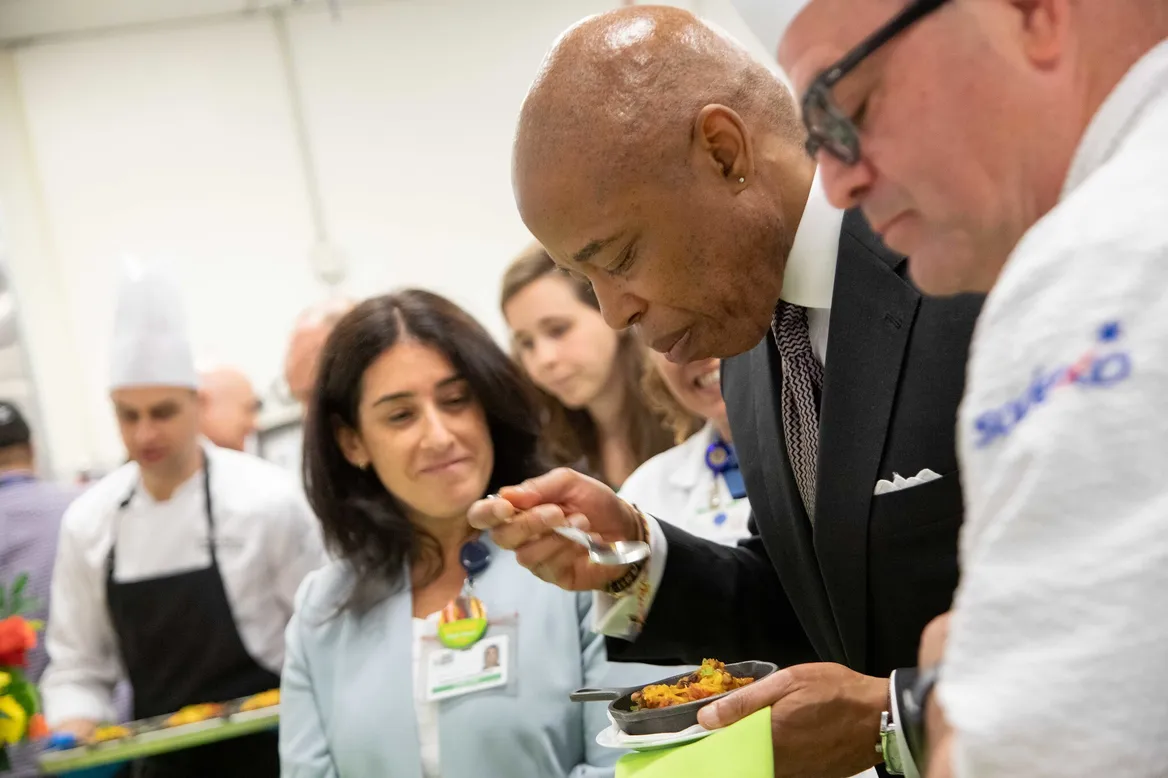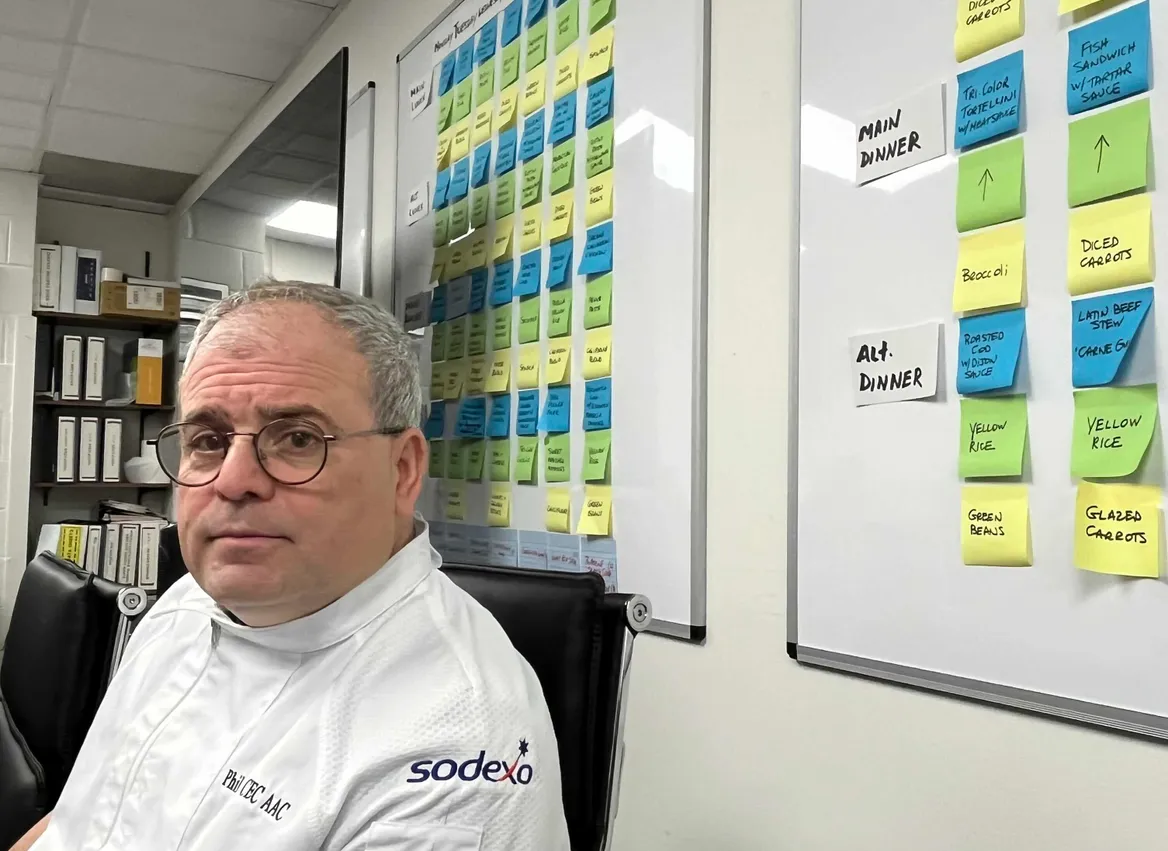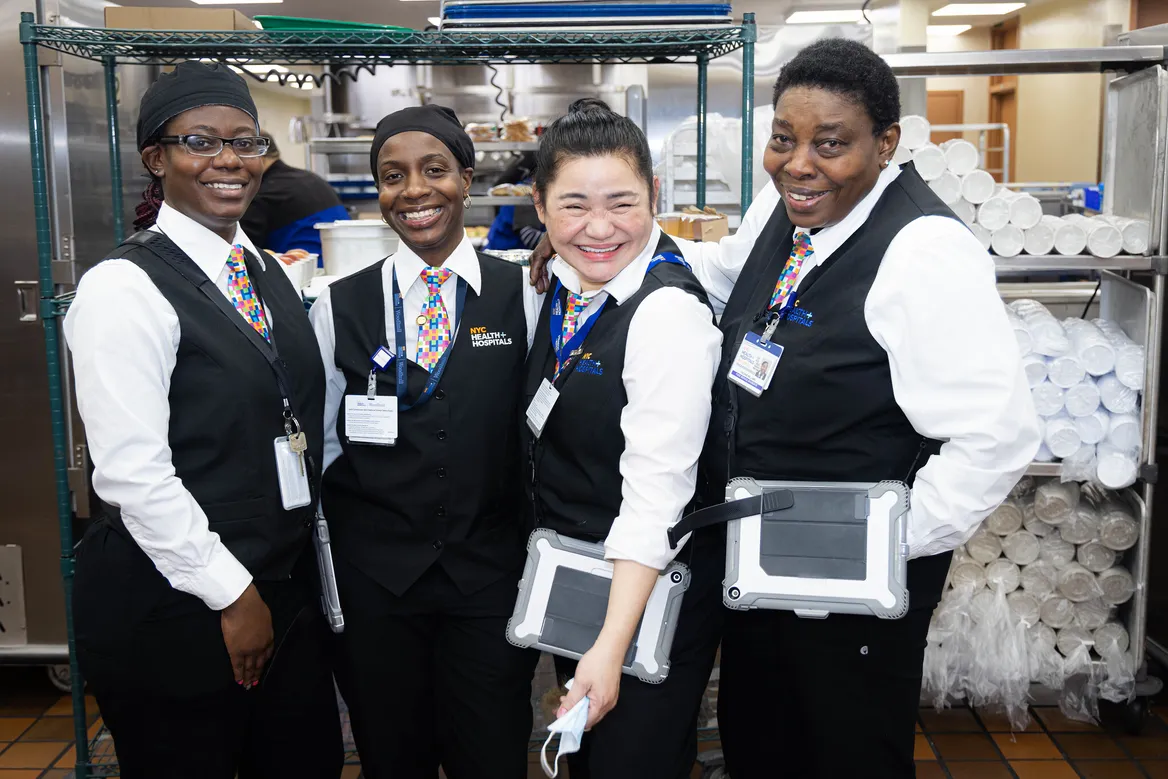Explainer
How Overconsumption Affects the Environment and Health, Explained
Climate•12 min read
Solutions
New York City is cutting emissions and saving money by making vegetarian meals the default in public hospitals. It’s successful because most people go with the flow.


Words by Michael Grunwald, Canary Media
This article originally appeared on Canary Media, an independent, nonprofit newsroom covering the transition to clean energy and solutions to the climate crisis.
The “Eating the Earth” column explores the connections between the food we eat and the climate we live in.
NEW YORK — Our food system generates one-third of our greenhouse gas emissions, and the human race has made almost no progress reducing them. Except in New York City’s public hospitals.
Before the city deployed an innovative new strategy two years ago to shrink its “carbon foodprint,” 99% of its patient meals included meat. Now more than half are vegetarian, generating 36% fewer emissions. While vegan activists have mostly failed to get us to ditch meat through education campaigns and yelling, and biotech entrepreneurs have mostly failed to convert us to plant-based substitutes designed to mimic meat, bureaucrats working for embattled Mayor Eric Adams have engineered a radical dietary shift.
Sitting in her bed in the surgical ward at Brooklyn’s Kings County Hospital, pointing at a clean plate that minutes earlier was covered with mushroom stroganoff, 60-year-old Pamela Sumlin-Gambil revealed the secret of the city’s success.
“I normally take what they offer me, you know?” she said with a shrug.
That’s the strategy. Food service associates in the city’s 11 public hospitals are trained to tell patients the chef recommends the sweet potato burrito, the red curry vegetable stew, or another plant-based meal. If the patient doesn’t bite, the associate offers a three-bean chili, a black-eyed pea casserole, or another meatless dish. If the patient says no twice, then the associate suggests a meat option. But 51% of patients don’t say no twice.
In behavioral science, this kind of nudge is known as making the preferred option the “default,” and it’s a weirdly powerful hack. When employees are automatically defaulted into a 401(k) plan, they tend to stay in it and save more for retirement; when consumers buy new TVs with a low-power default setting, they tend to leave them that way and use less power. We’re an inertial species, predisposed to accept the status quo, so “choice architecture” really matters. As Sumlin-Gambil said, we normally take what’s offered to us — and when what’s offered is better for the climate, we inadvertently reduce our impact on the planet.
The one caveat with food is that we stop taking what’s offered to us when we don’t enjoy it. That’s why New York has paired its default strategy with a conscious effort to serve delicious, nutritious, and culturally resonant plant-based meals with clean ingredient lists. And it’s working; the food service giant Sodexo, which has now served the city’s patients more than 2 million plant-based meals, reports a 98% satisfaction rate. The average vegetarian meal costs 59 cents less than meat, so the program has also saved the city more than $1 million.

In fact, the program has worked so well that Sodexo plans to expand plant-based defaults to all 400 U.S. hospitals it serves. At a time when humans already use one-third of the earth’s habitable land to raise livestock, and we’re expected to eat 50% more meat by 2050, the New York hospital experience offers hope that vegetarian defaults at universities, corporate cafeterias, and other institutional settings could help us eat less. Officials from Canada, Denmark, Germany, the U.K., and several other countries have already visited to learn how they could reduce their food emissions through defaults of their own.
“What’s so exciting is the way this retains freedom of choice. Nobody’s forced to go vegan,” said Katie Cantrell, cofounder and CEO of Greener by Default, a nonprofit that has advised New York City and Sodexo on their behavioral approach. “The idea is to make the sustainable choice the path of least resistance, without getting into the big political and cultural fights.”
Feeding the world without frying it will be one of the 21st century’s most daunting challenges. We’ll have to eat less meat, waste less food, stop clearing wilderness for new farmland, and make more food on existing farmland. I’ve written Canary columns about several promising solutions — fake meat, more efficient ranches, a super-tree called pongamia — and a bunch more appear in my upcoming book about our eating of the earth. But none of those solutions are really moving the needle yet, which is why we’re currently on track to deforest another dozen Californias worth of land by 2050.
Offering black bean enchiladas to hospital patients actually does seem to move the needle.
These days, Mayor Adams is best known as the trash-talking rogue who quit the Democratic Party after the Trump administration made his corruption charges disappear. But his main claim to fame used to be his plant-based diet, which he credited with helping him lose 35 pounds and cure his diabetes in a book titled “Healthy at Last.” Even his veganism has attracted media skepticism — he confessed to occasional lapses after reporters caught him eating fish — but he’s been a consistent advocate for plant-based eating, and his administration has pushed more plant-based protein into the city’s schools, jails, and homeless shelters.

The hospital initiative is the centerpiece of New York’s efforts to reduce meat-eating, and Kate MacKenzie, executive director of the Mayor’s Office of Food Policy, says the default strategy is the key to driving change without provoking backlash. Most people like meat. They don’t want to be told to give it up to save the earth or even their health. But they’re not necessarily committed to eating it all the time, either. They’ll try what’s offered, if it sounds good, especially when they’re confined to a hospital bed.
“It’s not plant-based or bust. It’s not giving the food a label, so people say it’s not for them because they’re not that,” MacKenzie said. “We nudge you towards choices that are better for you and the planet, but if you really want meat, you can still get it.”
When Sodexo Chef Phil DeMaiolo created the recipes for the city’s plant-based hospital meals, his top priorities were to make them tasty and reminiscent of home, because patients who don’t eat don’t get well. The dishes are prepared in a central “culinary center” in Brooklyn with culture and demographics in mind — a stew called sancocho in Latin neighborhoods, featuring root vegetables instead of chicken or pork; red curry tofu for Indian communities; a penne pesto like the ones he ate as an Italian-American kid in Bedford-Stuyvesant. Asian patients didn’t love a pad thai without fish sauce, so DeMaiolo yanked it off the menu.

He doesn’t serve Impossible or Beyond burgers — not because he thinks there’s anything wrong with fake meat, just because he wants to serve more natural and recognizable vegetarian dishes.
“It’s gotta be authentic, and it’s gotta have flavor — not ‘hospital food,’ just good food,” DeMaiolo said. “Then you gotta advertise it right, and do some education.”
There’s behavioral science behind the advertising, too; studies show that calling dishes “vegan” or “vegetarian” is a turnoff to omnivores, while adjectives like “zesty” or “hearty” are much more enticing than “healthy” or “sustainable.” Even though plant-based meals are almost always better for the climate than chicken or pork, and dramatically better than beef or lamb, describing their climate benefits is apparently counterproductive. Most people prefer to associate food with comfort, joy, and their grandmother’s kitchen, not the boiling of the planet. In general, it helps to focus on the appeal of the meals, rather than their lack of meat; people want to feel like they’re getting something, not being denied something.

DeMaiolo says the education component is even more important to the program’s success. He began by taking field trips to all 11 hospitals, providing samples to CEOs, doctors, nurses, and janitors, getting their input as well as their buy-in. Then the real education is done by trained food service associates who not only recommend plant-based options to the patients but let them know about the nutritional benefits of each dish and eventually send them home with green and healthy recipes they can cook themselves.
At Kings County Hospital, a nearly 200-year-old institution in the East Flatbush neighborhood of Brooklyn, a Moroccan-born food service associate named Hassan Ouhassi took his iPad to Sumlin-Gambil’s bed to make sure she had liked her mushroom stroganoff. She had; she said it tasted just like beef. He agreed; he tries every dish himself.
“I tell them it’s healthy food, I tell them they’ll like it, and they do!” Ouhassi said. “They clean their plates. Sometimes they ask for meat, which is fine. Not usually, though.”
This is the power of defaults: We’re much more likely to register to vote, sign up to be an organ donor, or renew our Netflix subscription when we have to opt out rather than opt in. Changing behaviors is hard, and we’ll have to change quite a few to maintain a habitable planet, so New York’s nudges could be a powerful model.
Mayor Adams embarked on his plant-based journey for health reasons, after he went nearly blind in one eye and his doctors told him he’d need diabetes drugs the rest of his life, so hospitals were the perfect venue to try to deploy his plant-based vision. But his food policy team is just as focused on climate. It’s set a goal of reducing the city’s food-related emissions by one-third by 2030, and shifting from meat to plants is the best way to do that. The team is expanding plant-based meals in schools and other city-run institutions while securing commitments from private institutions like Columbia University, the Bronx Zoo, and The Rockefeller Foundation to reduce their own food-related emissions by one-fourth.
MacKenzie, the director of the food policy office, says her strategy is simple: Buy less beef, offer more plants, focus on taste, and don’t guilt anyone. The city government’s emissions from food purchases are down 29%. That’s quite an achievement, because global food emissions are rising fast, mainly because global meat consumption rises just about every year.
To meet the 2050 emissions targets in the Paris climate accord, consumers in rich countries will have to reduce their consumption of meat, especially ruminant meats like beef and lamb, by about half. The problem is, our ancestors began eating meat 2 million years ago, and it literally helped make us who we are; we evolved bigger brains to help us find meat, and smaller stomachs because we didn’t need to digest as many plants. Animal flesh will be an extremely hard habit to break, which is why the default strategy that relies on our mindless willingness to outsource our dietary choices holds such promise.
“People are overwhelmed, there’s a cacophony of information thrown at them, they’ve got too many decisions to make — sometimes they just want to be told what to do,” said Eve Turow-Paul, executive director of the nonprofit Food for Climate League, which helped design the messaging for the default program. “If you can make the good choice the easy choice, without getting into the political bickering of ‘you’re taking away my burger,’ you can help people and the planet.”

The animal rights movement has tried to turn Americans against meat by exposing the cruelty of factory farms, throwing blood at models wearing fur, and holding a lot of noisy demonstrations. Biotech startups like Beyond Meat and Impossible Foods have tried to stop the expansion of animal agriculture by offering meat substitutes that tasted, smelled, and seared like the real thing. But if anything, Americans are even more committed to eating animals, as “meatfluencers” get rich on the internet and “carnivore diets” trend on Instagram.
There are plenty of exciting potential food and climate solutions, but none of them are reducing many emissions yet. My family no longer wastes food at home, because we’ve got a food waste dehydrator that converts our kitchen scraps into chicken feed, but less than 0.1% of American households have one. Pongamia trees produce more food than soybean plants on much worse land, but so far they’ve only been planted on about 0.01% of American farmland.
But plant-based defaults seem easy to implement, easy to scale, and remarkably effective. And unlike Meatless Mondays or plastic-straw bans, they don’t seem to induce defensiveness or hostility.
“We’re living in such depressing and polarizing times,” said Cantrell, the Greener by Default cofounder. “Well, this is something uncontroversial that actually works!”